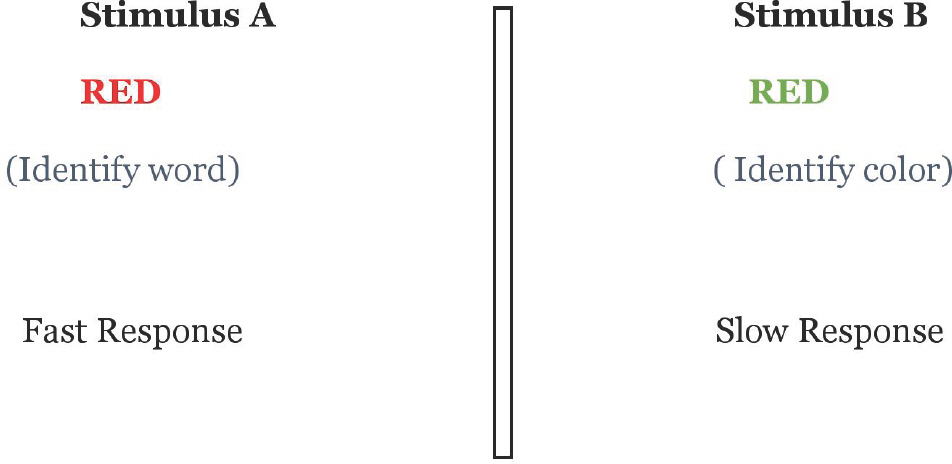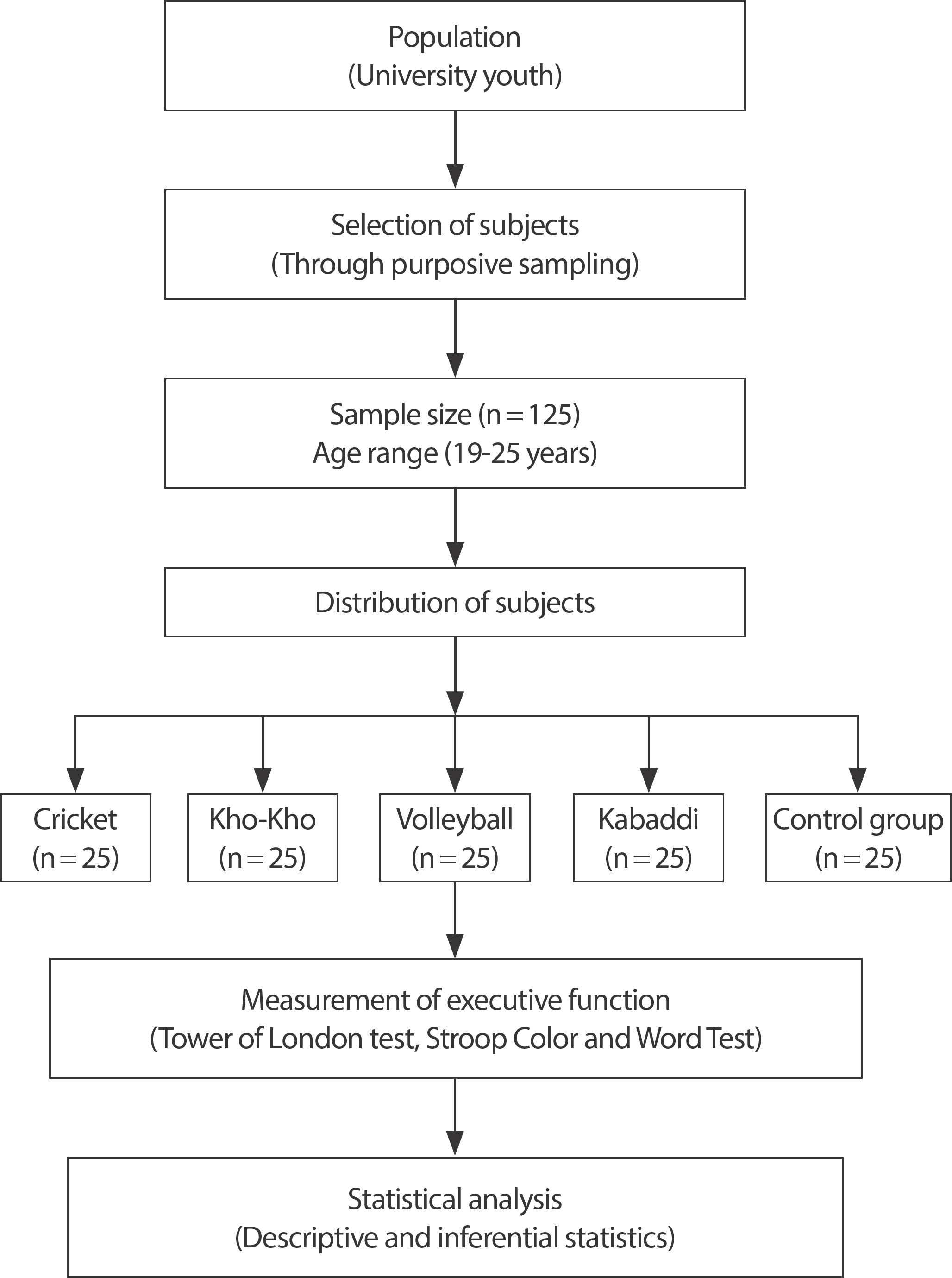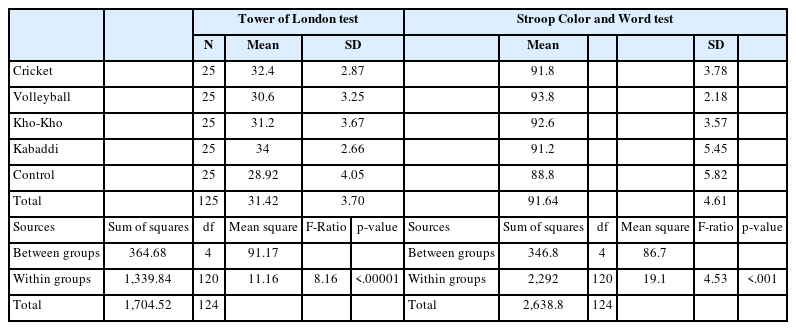Team Sports and Executive Functions: A Comparative Observational Pilot Study
Article information
Abstract
PURPOSE
This study aimed to compare the executive functional ability among participants regularly practicing and participating in four different sports, including Cricket, Volleyball, Kho-Kho, and Kabaddi, and the active control group.
METHODS
This pilot study included 125 university youths aged 19-25 years. Twenty-five participants were selected for each of the four different sports disciplines, including Cricket, Volleyball, Kho-Kho, and Kabaddi, to meet the purpose of the study. Twenty-five active, healthy male participants served as the control group. Moreover, participants in the control group did not regularly engage in organized sports; however, they were all recreationally active and healthy. The Executive Functions (EFs) of all sampled participants were assessed using the Tower of London (TOL) and Stroop Color and Word Test (SCWT). Mean, standard deviation, one-way analysis of variance (ANOVA), and Tukey's honest significant difference (HSD) post-hoc tests were used for data analysis and interpretation.
RESULTS
One-way ANOVA demonstrated significant differences among groups in both tests; thus, the post-hoc Tukey's HSD test was conducted, which gave pairwise comparisons between and within groups. Pairwise comparison of the TOL test indicated significantly higher EFs in Kabaddi players than those in the Volleyball (p<.01), Kho-kho (p<.05), and the control (p<.001) groups; however, there was no significant difference between the Kabaddi and Cricket groups. The Cricket group demonstrated higher EFs than the control group (p<.05). The pairwise comparison results of the SCWT test indicated significantly higher EFs in Volleyball (p<.001) and Kho-kho (p<.05) players than those in the control group.
CONCLUSION
This study demonstrates that people involved in regular physical and team sports activities have higher EFs than non-trainer active control individuals.
INTRODUCTION
Executive functions (EFs) are commonly described as a set of high or-der cognitive processes controlled by the frontal and sub cortical areas, especially the prefrontal cortex of the brain. EFs develop and mature across the lifespan, slowly from childhood being less specialized, through adolescence with synaptic pruning processes up to early adulthood, char-acterized by complete maturation [1,2]. EFs comprise of basic cognitive processes such as inhibition [inhibitory control, including self-control (behavioral inhibition) and interference control (selective attention and cognitive inhibition)], working memory (WM), and cognitive flexibility which enhance some areas of the psychological domain such as reasoning, problem solving, planning, attention etc. [3-5]. The concept of executive programming and its links to the pre frontal lobe began appearing in the mid-19th century [6], while the term was first used by Karl Pribram in 1973 [7]. These mental processes control the human goal directed behavior through three main dimensions which are working memory, inhibition and cognitive flexibility. In 1994 Kramer et al., did a breakthrough research on the inhibition behaviors and planning, task coordination, initiation and processing of semantic information. The relation between physical activity and cognition has been equated through several docu-mented literatures, while the specific descriptors used to describe the subcomponents of executive function have been modified slightly in the physical activity literature and typically described as planning, scheduling, inhibition, and working memory [8]. There are multiple evidences that indicate a positive impact of physical activity and sports on EFs. Jo-hannes W. de Greeff et al. [9], found positive effects for both acute physical activities as well as for longitudinal physical activity programs on executive functions. Valentin Benzing et al. [10], reported that regular practice of physical activity acts as a therapy to increase the EFs even in neu-rodivergent children. Few other evidences claimed that continuous involvement in physical activity and sports helps in activation of the prefrontal cortex, cerebellum, and basal ganglia, which directly impact executive functioning through their complex motor tasks [11-13]. Several researchers have proposed that, different types of sports may influence EFs in terms of movement, motivation, and emotional enhancement, social interaction and cooperation [14-16]. Team sports may also be a resulting factor for better EFs [17]. Every team sport is played based on open skills in the form of a group, and they are otherwise termed as such.
In this present study authors included four team sports in which two (Kho-Kho & Kabaddi) are popular indigenous games (Indian) and other two (Cricket & Volleyball) are ball games which are popular across the globe. Based on the different distinctive patterns, movements and skills these four team sports players may need different level of EFs ability.
No study is performed regarding indigenous games (Indian) and cricket on EFs while very few studies were done on volleyball so far that is why the researchers have attempted so in the current study.
The purpose of the present observational study was to compare the executive functional ability among participants regularly practicing and participating in four different types of team games-Cricket, Volleyball, Kho-Kho, Kabaddi and the active control group.
METHODS
1. Participants
The researchers recruited a total of 125 subjects for this study. 25 subjects from each discipline i.e., Cricket (n=25), Kho-Kho (n=25), Volleyball (n=25), and Kabaddi (n=25) along with the group of subjects who were recreationally active and healthy were considered under the active control group (n=25). For the recruitment of the university level players, researchers and the university sports board jointly organized an orientation program and explained about the study, only willing players were considered and included in this study.
However, to form active control group the researchers distributed handouts to the different departmental students of the parent institute, Jadavpur University. Those who are willing to participate and fulfill the criteria of this study are asked to join in the experiment. All the willing subjects are asked to fill the individual consent form. Finally, five distinctive groups were formed through purposive sampling to meet the purpose of experiment.
2. Location of the study
The study was conducted at the Exercise and Sports Physiology labo-ratory, Department of Physical Education, Jadavpur University.
3. Inclusion and exclusion criteria
Players who have university sports achievements in their respective fields and at least three year's regular active involvement in inter university level sports competition were considered as subjects in this pilot study. The age sex matched subjects aged between 19-25 years assigned for the control group who did not participate in any organized sport activities in regular basis, were all recreationally active and healthy individuals. All the subjects of this study were stayed in the hostel and also regular students of the university thus they followed a similar lifestyle in terms of biological clock and diet pattern.
4. Administration of test
For measuring executive ability, the researcher collected data by using Tower of London (TOL) test and Stroop Color and Word Test (SCWT) from verified online sources. The Tower of London test is usually used in applied clinical neuropsychology for the assessment of EFs [25].
The TOL test comprises of three wooden pegs of different lengths mounted on a strip of wood and three colored balls (red, green, blue) that are manipulated on the pegs to reproduce a predefined picture end state. However, there are some rules based on mental skills which need to be followed to complete the task, first of all subject can move only one ball at a time, secondly they cannot place the balls anywhere else other than the three pegs, thirdly subjects can only place three balls on the left peg, two on the middle peg, and one ball on the right peg to finally make the predefined pattern in a possible number of moves and time period. Number of moves of each level will be displayed in the upper right corner of the screen [18,19] (Fig. 1). In case of any error from the participants’ end, the ‘ reset button’ helps to return to the starting position. After completion of all the levels, the final score displayed on the screen which will be considered as the final score of the participant. This test is widely used for measuring planning and problem solving ability of an individual.
SCWT is a neuropsychological test broadly used for both experimental and clinical purposes. Both represent the “ jumble condition” in which participants are required to perform in response to congruent and incongruent stimuli. In congruent condition participants are asked to identify the word instead of colors. For example, the word ‘ Red’ written in red color ink so in this condition participants are required to identify the word only. Conversely in incongruent condition participants are asked to identify the colors instead of words. For example, the word “ Green” is printed in red ink. Thus, in this condition, participants are required to identify the name of the color ink instead of reading the word [20] (Fig. 2). Twenty levels are there and the complexity of the levels increases gradually. The SCWT is widely used to measure the Stroop effect [21], ability to inhibit cognitive interference; previous study also reported its application to measure other cognitive functions such as attention, processing speed, cognitive flexibility [22] and working memory [23]. In this present study the researcher collected data by using online verified tool. After collecting the numerical data researcher analyzed the data through descriptive and inferential statistics. Fig. 3, provides the detailed Trial Profile with the enu-meration of the primary outcomes.
5. Statistical analysis
Tukey Honestly Significant Difference (HSD) [24] test was used to check the numerical normality and it was found that the data was normally distributed. Mean and Standard deviation were performed as descriptive statistics and One-way Analysis of Co-Variance (ANOVA) was computed as inferential statistics to compare cognitive outcomes of players involved in Cricket, Kho-Kho, Volleyball, Kabaddi games and the active control group. In this present study independent variables were four different discipline of sports with age matched control group and the dependent variable were the obtained scores of EFs task measured through TOL and SCWT. The level of significance was set at p ≤.05.
RESULTS
Descriptive statistics and inferential statistics were performed based on the obtained data acquired through TOL test and SCWT of all Cricket, Volleyball, Kho-Kho, and Kabaddi and age-sex matched active control group which is shown in Table 1. Significant differences among groups were found in both tests through the One-way ANOVA thus Post Hoc Tukey HSD test was conducted which gave pair wise comparisons between and within groups detail as shown in Table 2. Pair wise comparison result of TOL test using Tukey HSD Post Hoc Test clearly indicates significantly higher EFs in Kabaddi players in comparison to Volleyball (p<.01), Kho-Kho players (p<.05) and the control group (p<.001) while there was no significant difference between Kabaddi and Cricket group. Cricket group demonstrated higher EFs in comparison to the control group (p <.05). On the other hand, pair wise comparison results of SCWT test using Tukey HSD Post Hoc Test clearly indicates significantly higher EFs in Volleyball (p<.001) and Kho-Kho (p<.05) players in comparison to the control group.
DISCUSSION
The present study aimed to compare the executive functional ability among participants involved in Cricket, Volleyball, Kho-Kho, Kabaddi and the active controls. This study may be first time attempt where indigenous games (Kho-Kho & Kabaddi) and Cricket have been considered to be an intervention as a comparative model on university level players.
Existing research literature has exhibited participation in team sports, might show stronger associations with EFs than other types of sports and physical activity that require less cognitive engagement [25]. Studies with physical activity intervention have previously demonstrated that in case of healthy children, adult, older population and even in ADHD children, regular practice of physical activity or involvement in sports has definitive positive effect on EFs. Few researchers have mentioned that development of EFs through sports activity rely on the movement involved in the activity [26,27]. Based on environmental impact on motor skills, motor skills can be classified as open or closed skills [28]. Team sports i.e., Football, Volleyball, Cricket, Kabaddi require to perform open skills which include complex cognitive process like attention, active decision making, perception, planning, strategy development, ongoing adaptability [28-30]. On the other hand, athletic events i.e., javelin throw, discus throw, shotput etc. closed skills which require lesser cognitive involvement, minimum variation of movements and are performed in a predictable environment [28,29]. People involved in open skills need to accommodate themselves in a continually changeable atmosphere and they are typically hypothesized with better EFs rather than those who involved in closed skills [29,31,32]. The mechanism of EFs through physical activity and sports has been shown in Fig. 4.
Soccer is a team sport as well as a ball game. It typically needs to be performed with open skill implementation. Previous research work on EFs on soccer player highlighted increased EFs [33]. It may relate with the other open skill team sports as well. Research work of EFs on elite volleyball players represented minimal degree of cognitive flexibility for highly specialized athletes and a maximum level for spiker outside hitters [24].
In this study, a significant relationship was observed between team sports practitioners and EFs. The sum up, based on the result in this study through TOL and SCWT measurement clearly indicates that, people involved in sports and physical activity have higher EFs than the active control group. The limitations being if the measurement of sedentary individuals could have given a more clear understanding about the importance of physical activity or sports activity and EFs. The sociodemographic status of the participants was not considered in this study. The present study was conducted on 125 subjects, a larger sample size with more sports disciplines may be measured in the future, to give a more specified result.
CONCLUSION
The findings of the present study highlight the development of EFs through physical activities and team sports. Positive and significant relationships have been drawn within the limitations of this study; between team sports activities and EFs. This study demonstrate that people in-volve in Kabaddi game have comparatively higher level of EFs than other three team sports (Kho-Kho, Cricket, Volleyball). Simultaneously the study indicated athletes of every included team sports have comparatively greater EFs than the control group. In short it is clearly signified that people involved in team sports activities have higher inhibitory control, self-control and cognitive flexibility compared to the non-trainer controls.
Notes
The authors declare that there is no conflict of interest.
AUTHOR CONTRIBUTIONS
Conceptualization: S ChatterJee; Writing Original draft: P Paul; Re-view and Editing: P Bhattacharya, D Roy.






